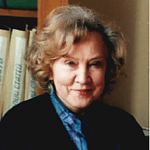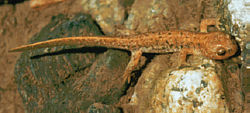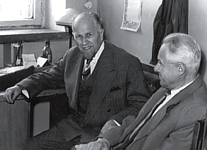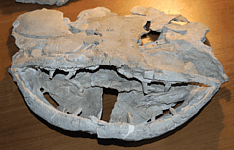
 | Laboratories \ Laboratory for Evolutionary Morphology \ Goals and Tasks |
| Goals and Tasks |  | Publications |  | Scientific Staff |
 |
LABORATORY FOR EVOLUTIONARY MORPHOLOGY
MAIN GOALS AND TASKS
Academician E.I. Vorobjeva 
One of the objects of study – Ranodon sibiricus 
Professor B.S. Matveev (left) and
The studies were undertaken in the direction of revelation of the patterns of rates and mechanisms of morphological macroevolution in modern and fossilized vertebrates (fishes, amphibians, reptiles) by the study of different systems of their organs with comparative and experimental methods. For the period of 10 years several conceptions were developed and methodological basis for further studies of morphological evolution of vertebrates was formed. Among them there were: A modern elaboration of the concept about organism integrity in onto- and phylogenesis according to I.I. Shmal'gauzen as a unit of integrity of biosphere was presented, which relied on cybernetic approach and interaction of genetic and epigenetic factors of evolution. A concept about a leading role of phylogenetic heterochronia, first of all of paedomorphosis was substantiated in the formation of morphofunctional innovations and coming into being of novel taxa at the level of lower vertebrates and reptiles. This in its turn led to the revaluation of traditional criteria and principles of phylogenetics, accentuating attention on the role of ontogenic diversifications in formation of biodiversity and on genesis of structural transformations. A new approach to the question about the origin of terrestrial vertebrates was suggested, based on morphogenetic interpretation of evolutionary-morphological events and initial water radiation of tetrapods. On the basis of complexation of paleontological, comparative embryological and genetic data, the scheme of the skeleton reorganization of paired fins of sarcopterygii into paired extremities of tetrapods was given; it was shown that their finger arch was a new formation. The sequence and the rate of formation of mesenchymal and cartilaginous germs in the pads of different species (and populations) of Caudata (tailed amphibians) - primitive and advanced, limnophilous and reophilous, and also the sequence of the pad elements ossification were traced. It was shown that asynchronism in these sequences was connected with heterochronia of development and larval adaptations. The patterns of morphofunctional and morphogenetic reorganizations of the cranium in the evolutionary-morphological range of palaeozoic Crossopterygii fishes - fossil amphibians and modern amphibians were found out. It was shown that an important role in these transformations was played by paedomorphosis. Based on the original experimental studies and the analysis of literary data, a concept of controllability of metamorphosis in evolutionary-morphological ranges of fishes and amphibians was suggested and the evaluation of the factors, determining this controllability was given. 
Paleozoic Crossopterygii fish Laccognathu On the concrete materials on Caudata development it was shown that their evolution was followed by progressive divergence of morphology in the larval and adult phases and by progressive concentration at the phase of metamorphosis of an increasing number of morphogenetic processes that was accompanied by perfection of the system of metamorphosis regulation, in advanced forms by the way of strengthening of the role of thyroid hormones as metamorphosis regulative factors. It was determined experimentally that if in amphibian at early phases of ontogenesis thyroid hormones played insignificant role in ontogenesis regulation and their importance became apparent only in the period of metamorphosis, in bony fishes (Osteichthyes) the most sensitive phases to the action of these hormones were the early ontogeny phases. By the example of bony fishes (African barbel) it was found for the first time that paedomorphosis could be achieved by acceleration of the rates of their somatic development. The characters of paedomorphic underdevelopment of the roof of the cranium in Polyodon spathula were revealed. Comparison of this species with sturgeons demonstrated that regardless of traditional and most diffused opinion the connection with the lateral line canal could not serve as a deciding argument under homologation of integumentary ossifications. At that, Y-shaped bonds of the canals (as in the case of exstrascapulare laterale) served as "epigenetic traps" (sensu Wagner, 1991), determining the same specific morphology of the bone independently of the source of embryonic material of this species. An experimental work devoted to revelation of thyroid hormones (TH) role in the formation of the skeleton in the ontogeny of Anura (tailless amphibians), and also goitrogenes, suppressing the function of the thyroid gland was conducted. It was shown that contrary to Caudata, in Anura (by the example of a grass frog, Rana temporaria) development of all without exception cranium bones were under more or less expressed influence of TH, at that for the earlier ossifications TH played a role of regulators, and for the later ones - the role of obligate inductors. Artificial increased or lowered level of TH during larval development could substantially influence on the body proportions (relative length of the extremities) in fingerlings of R. temporaria upon metamorphosis finishing by them. On the basis of the study of reorganizations of skeletal-muscular and other systems of organs in vertebrate evolution, a concept of two levels (and phases) of macroevolutionary processes was developed: of the lower one (macrogenesises - marked, large-scale changes of separate structures and organs) and of the higher one (typogenesis - formation of the general pattern of organization on the new macrotaxon). The mechanisms of initial macrogenesises were determined, which could develop both by the way of gradual microevolutionary changes and (more rarely) on the basis of relatively large morphofunctional saltation transformations, affecting separate features and correlation complexes of the features of the organisms. It was shown that intensification of organ functions in evolution could be achieved besides the known previously ways (the changing of the quantity and quality of structural elements, according to A.N. Severtsov) also by the way of the changes in systemic organization, allowed the optimization of the system components interaction. For the first time the differences in skeletal and muscular structures of maxillary apparatus in all 8 modern families of Caudata were characterized. Evolutionary reorganizations and homology of several cranium muscles in amphibians and reptilians were clarified. A comparative morphofunctional analysis of hyobranchial apparatus in osteolepiform and porolepiform fishes was carried out and reconstruction of their hypobranchial muscle differences was given. The studies on biodiversity, resources and conservation of amphibians in Northern Eurasia were conducted. It was determined that the most serious reductions of amphibian populations were observed in European regions. The main reason was anthropogenic actors (forest destruction). Out of natural negative factors, the basic one was evidently a natural change of plant association, which led to eutrophication and obliteration of waterbodies. The reductions of populations of separate species were not connected with their phylogenetic and systemic status. The works were led on the study of condition of released juvenile acipenserids (sturgeon, beluga, stellate sturgeon) from fish factories of the Volgo-Caspian Region under anthropogenic pressing. Two most mass anomalies influencing the vital activity of released juveniles were revealed - cataract and thinned abdominal cavity up to a break and fallout of inner organs (due to underdevelopment of abdominal muscles). It was determined that cataract represented two independent diseases of the fishes, each of which had its own ethiology. |